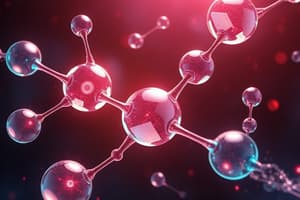Podcast
Questions and Answers
¿Qué partículas componen principalmente un átomo?
¿Qué partículas componen principalmente un átomo?
- Electrones y protones
- Neutrones y electrones
- Protones y neutrones (correct)
- Neutrones y positrones
¿Cuál es la función de los neutrones en un átomo?
¿Cuál es la función de los neutrones en un átomo?
- Ayudar a mantener la neutralidad del átomo (correct)
- Llevar una carga negativa
- Determinar las propiedades químicas del átomo
- Orbitar alrededor del núcleo
¿Qué representan las moléculas en química?
¿Qué representan las moléculas en química?
- La carga negativa de un átomo
- El núcleo de un átomo
- La carga positiva de un átomo
- La unión de varios átomos (correct)
En química, ¿cómo se definen los átomos?
En química, ¿cómo se definen los átomos?
¿Qué tipo de enlace químico se forma entre átomos para crear moléculas?
¿Qué tipo de enlace químico se forma entre átomos para crear moléculas?
¿Cuál es la diferencia principal entre los electrones y los neutrones en un átomo?
¿Cuál es la diferencia principal entre los electrones y los neutrones en un átomo?
¿Qué tipo de enlace se forma cuando los átomos comparten electrones en pares para lograr configuraciones electrónicas estables?
¿Qué tipo de enlace se forma cuando los átomos comparten electrones en pares para lograr configuraciones electrónicas estables?
¿Qué tipo de atracción se forma entre iones cargados opuestamente en un compuesto iónico?
¿Qué tipo de atracción se forma entre iones cargados opuestamente en un compuesto iónico?
¿Qué unidades químicas están formadas por átomos de diferentes elementos compartiendo electrones a través de interacciones covalentes?
¿Qué unidades químicas están formadas por átomos de diferentes elementos compartiendo electrones a través de interacciones covalentes?
¿Qué tipo de enlace es característico de los metales, donde los electrones se mueven libremente entre los átomos?
¿Qué tipo de enlace es característico de los metales, donde los electrones se mueven libremente entre los átomos?
¿Qué propiedad atómica es crucial para predecir cómo los átomos se combinarán para formar moléculas con propiedades químicas únicas?
¿Qué propiedad atómica es crucial para predecir cómo los átomos se combinarán para formar moléculas con propiedades químicas únicas?
¿Cuál es la función principal de estudiar las propiedades atómicas y los enlaces químicos en química?
¿Cuál es la función principal de estudiar las propiedades atómicas y los enlaces químicos en química?
Flashcards are hidden until you start studying
Study Notes
General Chemistry: Understanding Atoms and Molecules
In the realm of chemistry, two fundamental concepts are crucial to comprehend: atoms and molecules. Let's delve deeper into what these terms mean and how they relate to the broader field of chemistry.
Atoms
Atoms are the basic building blocks of all matter and are defined as the smallest unit of an element that retains its unique chemical properties. However, atoms themselves cannot exist independently in nature, due to their extremely small size; they are held together by forces called atomic bonds. Atoms are made up of three main types of particles: protons, neutrons, and electrons. Protons and neutrons reside in the nucleus of the atom, while electrons orbit around the nucleus. Electrons carry negative charges, whereas protons have positive charges. Neutrons bear no charge and help maintain the overall neutrality of the atom.
Molecules
Molecules represent the next level of complexity in chemistry, consisting of two or more atoms bonded together. They form the building blocks of chemical compounds and define the properties of elements and their reactions. Just like atoms, molecules can be positively charged, negatively charged, or neutral depending on the arrangement of their constituent atoms.
Bonding Between Atoms
Atoms combine to form molecules through two types of chemical bonds: ionic and covalent. In ionic bonds, electrons are transferred completely between the atoms involved, resulting in a positively charged atom and a negatively charged atom. This arrangement forms an electrostatic attraction between the oppositely charged ions, known as an ionic compound.
In contrast, covalent bonds form when atoms share electrons in pairs to achieve stable electron configurations. The shared electrons are not fully localized on either of the bonded atoms but rather exist within a region around both nuclei called the molecular orbitals. Covalent compounds consist of molecules that contain atoms of different elements sharing electrons through these interactions.
Relationship Between Atoms and Molecules
Understanding atoms is essential for grasping the behavior of larger groups of atoms, which are organized into molecules. By studying atomic properties such as size, charge, and bonding, we can predict how atoms will combine to form molecules with unique chemical properties. These molecules, in turn, determine the physical and chemical properties of elements and their reactions in various systems.
In summary, atoms and molecules are fundamental units of matter that play a crucial role in chemistry. Studying their nature, behavior, and interactions allows chemists to understand the principles underpinning the world around us and develop new materials, technologies, and solutions to challenging problems.
Studying That Suits You
Use AI to generate personalized quizzes and flashcards to suit your learning preferences.




